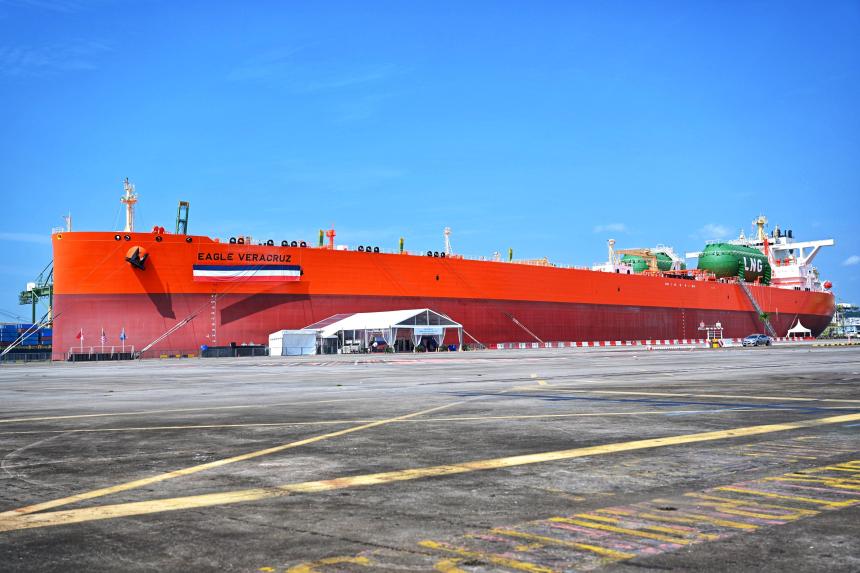SINGAPORE – Amid the move to reduce carbon emissions, a very large crude carrier (VLCC) partially powered by the less polluting liquefied natural gas (LNG) was launched by Minister for Sustainability and the Environment Grace Fu on Jan 23 at PSA Keppel Terminal in Tanjong Pagar.
“Shipping must play a role in reducing its emissions and contribute to the fight against climate change,” said Ms Fu to industry stakeholders and representatives from AET, the Malaysian-owned, Singapore-headquartered shipowner and global operator of crude and clean petroleum tankers.
Maritime and Port Authority of Singapore (MPA) chief executive Teo Eng Dih and senior officials from the Ministry of Sustainability and the Environment, Ministry of Transport, MPA and PSA also attended the naming ceremony of the VLCC, the Eagle Veracruz.
The launch marks the 100 million gross tonnage milestone for the Singapore Registry of Ships (SRS).
With a carrying capacity of 300,000 deadweight tonnes, the Eagle Veracruz is the third and final tanker delivered on long-term charter to Shell Tankers Singapore.
The addition of Eagle Veracruz under the Singapore registry means that the SRS, which administers about 4,000 vessels, ranks among the world’s largest ship registries with one of the youngest quality fleets, said MPA.
SRS oversees Singapore-flagged ships and ensures that they comply with the relevant International Maritime Organisation (IMO) conventions to enhance the safety, efficiency and environmental protection of international shipping.
Citing an IMO study, Ms Fu said greenhouse gas emissions from global shipping, which accounts for 3 per cent of total emissions, will continue to rise.
For international shipping to be more environmentally friendly, Ms Fu said that Singapore is working with like-minded partners to create sustainable maritime ecosystems, such as establishing green and digital shipping corridors to the Americas, Europe and Asia, and developing harmonised standards and regulations for the safe handling and bunkering of future marine fuel such as methanol, ammonia and hydrogen.
There are also opportunities to reduce fuel usage and costs by improving energy efficiency, noted Ms Fu, adding that retrofitting existing ships and building new ships to carry new green fuels in future are possibilities.

For instance, LNG-powered carriers like the new Eagle Veracruz are designed to reduce friction and improve efficiency while sailing, and are equipped with features to prevent methane gas in the LNG from leaking during storage.
The main engine in Eagle Veracruz is also built to allow for future retrofit options when fuels that produce low or zero carbon become more cost-effective.
Retrofitting can also help extend the lifespan of the VLCC “from a future-proofing perspective in the face of shipping emissions regulations”, said Mr Kavickumar Muruganathan, an energy, environment and economics lecturer at National University of Singapore.
He noted that because LNG bunkering infrastructure or facilities to pump LNG into vessels at ports worldwide are very limited, VLCCs are dual-fuelled with diesel.


